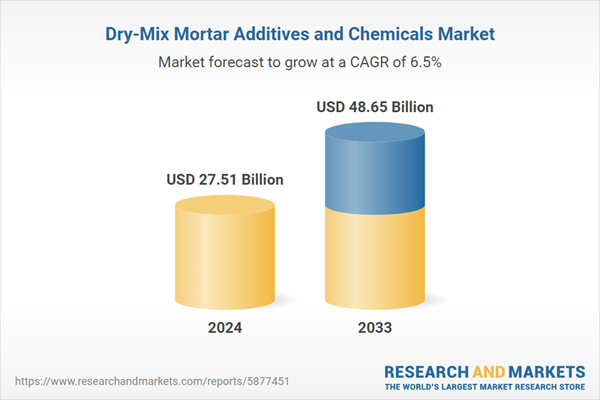Dry-mix mortar additives and chemicals are added to improve durability and performance. They comprise plasticizers, air-entraining agents, water repellents, accelerators, retarders, and defoamers. They are cost-effective, easy to use and transport, and can be stored in a container conveniently. They provide accurate sand and cement mixing ratio and only require potable water for creating a mixture. They assist in improving the adhesion between the mortar and various substrates, which decreases the risk of delamination or failure. They aid in lowering wastage of sand and cement, improving productivity, and reducing labor costs. Besides this, they are beneficial in enhancing the overall visual appeal of the finished construction. As they offer enhanced strength and workability while reducing downtime, the demand for dry-mix mortar additives and chemicals is increasing across the globe.
Dry-Mix Mortar Additives and Chemicals Market Trends:
At present, the rising adoption of dry-mix mortar additives and chemicals for fixing tiles on walls, floors, and swimming pools represent one of the major factors supporting the growth of the market. Besides this, the growing demand for dry-mix mortar additives and chemicals due to the rising number of renovation activities around the world is positively influencing the market. Additionally, the increasing adoption of dry-mix mortar additives and chemicals on account of their enhanced thermal insulation property is offering lucrative growth opportunities to industry investors. Apart from this, there is a rise in the demand for easy to apply, eco-friendly, and less time-consuming construction materials across the globe. This, coupled with the increasing adoption of re-dispersible polymer power, as it offers weather and abrasion resistance, reduces the water absorption of the material, and improves sag resistance and fluidity, is impelling the growth of the market. In addition, governing agencies of various countries are encouraging the construction of smart cities, which, in turn, is contributing to the growth of the market. Moreover, the growing utilization of dry-mix mortar additives and chemicals due to the rising demand for durable and low-maintenance solutions are offering a favorable market outlook. Furthermore, the increasing construction of roads and bridges across the globe is propelling the growth of the market.Key Market Segmentation:
The publisher provides an analysis of the key trends in each segment of the global dry-mix mortar additives and chemicals market, along with forecasts at the global, regional, and country levels from 2025-2033. Our report has categorized the market based on type.Type Insights:
- Additives
- Redispersible Polymer Powder
- Plasticizers
- Defoamers
- Cellulose Ether
- Air Entraining Agents
- Others
- Chemicals
- Shrinkage (Anhydrites)
- Retarders
- Na-Citrate
- Na-Tartrate
- Gypsum
- Phosphonate-Based Retarders
- Accelerators
- Ca-Formate
- Ca-Carbonate
- Ca-Nitrate
- Li-Carbonate
- CSH and CSA Accelerators
Regional Insights:
- North America
- United States
- Canada
- Asia Pacific
- China
- Japan
- India
- South Korea
- Australia
- Indonesia
- Others
- Europe
- Germany
- France
- United Kingdom
- Italy
- Spain
- Russia
- Others
- Latin America
- Brazil
- Mexico
- Others
- Middle East and Africa
Competitive Landscape:
The report has also provided a comprehensive analysis of the competitive landscape in the global dry-mix mortar additives and chemicals market. Detailed profiles of all major companies have been provided. Some of the companies covered include Ashland Inc., Avebe, Bisley International LLC, Dow Inc., Innospec Inc., Nouryon Holding B.V., Rudolf GmbH, SE Tylose GmbH & Co. KG (Shin-Etsu Chemical Co. Ltd.), Sika AG, Wacker Chemie AG, Zeiplast Chemical Industries Ltd., etc. Kindly note that this only represents a partial list of companies, and the complete list has been provided in the report.Key Questions Answered in This Report:
- How has the global dry-mix mortar additives and chemicals market performed so far, and how will it perform in the coming years?
- What are the drivers, restraints, and opportunities in the global dry-mix mortar additives and chemicals market?
- What is the impact of each driver, restraint, and opportunity on the global dry-mix mortar additives and chemicals market?
- What are the key regional markets?
- Which countries represent the most attractive dry-mix mortar additives and chemicals market?
- What is the breakup of the market based on the type?
- Which is the most attractive type in the dry-mix mortar additives and chemicals market?
- What is the competitive structure of the global dry-mix mortar additives and chemicals market?
- Who are the key players/companies in the global dry-mix mortar additives and chemicals market?
Table of Contents
Companies Mentioned
- Ashland Inc.
- Avebe
- Bisley International LLC
- Dow Inc.
- Innospec Inc.
- Nouryon Holding B.V.
- Rudolf GmbH
- SE Tylose GmbH & Co. KG (Shin-Etsu Chemical Co. Ltd.)
- Sika AG
- Wacker Chemie AG
- Zeiplast Chemical Industries Ltd.
Table Information
| Report Attribute | Details |
|---|---|
| No. of Pages | 139 |
| Published | March 2025 |
| Forecast Period | 2024 - 2033 |
| Estimated Market Value ( USD | $ 27.51 Billion |
| Forecasted Market Value ( USD | $ 48.65 Billion |
| Compound Annual Growth Rate | 6.5% |
| Regions Covered | Global |
| No. of Companies Mentioned | 11 |









